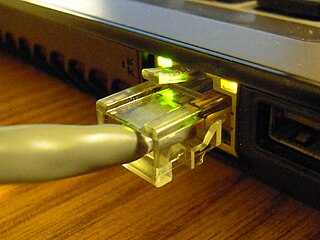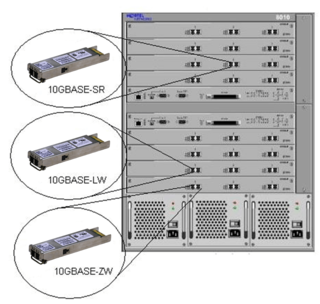
Ethernet is a family of wired computer networking technologies commonly used in local area networks (LAN), metropolitan area networks (MAN) and wide area networks (WAN). It was commercially introduced in 1980 and first standardized in 1983 as IEEE 802.3. Ethernet has since been refined to support higher bit rates, a greater number of nodes, and longer link distances, but retains much backward compatibility. Over time, Ethernet has largely replaced competing wired LAN technologies such as Token Ring, FDDI and ARCNET.

Network topology is the arrangement of the elements of a communication network. Network topology can be used to define or describe the arrangement of various types of telecommunication networks, including command and control radio networks, industrial fieldbusses and computer networks.

A telecommunications network is a group of nodes interconnected by telecommunications links that are used to exchange messages between the nodes. The links may use a variety of technologies based on the methodologies of circuit switching, message switching, or packet switching, to pass messages and signals.
The Spanning Tree Protocol (STP) is a network protocol that builds a loop-free logical topology for Ethernet networks. The basic function of STP is to prevent bridge loops and the broadcast radiation that results from them. Spanning tree also allows a network design to include backup links providing fault tolerance if an active link fails.
A virtual local area network (VLAN) is any broadcast domain that is partitioned and isolated in a computer network at the data link layer. In this context, virtual refers to a physical object recreated and altered by additional logic, within the local area network. VLANs work by applying tags to network frames and handling these tags in networking systems – creating the appearance and functionality of network traffic that is physically on a single network but acts as if it is split between separate networks. In this way, VLANs can keep network applications separate despite being connected to the same physical network, and without requiring multiple sets of cabling and networking devices to be deployed.

A wireless mesh network (WMN) is a communications network made up of radio nodes organized in a mesh topology. It can also be a form of wireless ad hoc network.

A mesh network is a local area network topology in which the infrastructure nodes connect directly, dynamically and non-hierarchically to as many other nodes as possible and cooperate with one another to efficiently route data to and from clients.

The RapidIO architecture is a high-performance packet-switched electrical connection technology. It supports messaging, read/write and cache coherency semantics. Based on industry-standard electrical specifications such as those for Ethernet, RapidIO can be used as a chip-to-chip, board-to-board, and chassis-to-chassis interconnect.

A computer network is a set of computers sharing resources located on or provided by network nodes. Computers use common communication protocols over digital interconnections to communicate with each other. These interconnections are made up of telecommunication network technologies based on physically wired, optical, and wireless radio-frequency methods that may be arranged in a variety of network topologies.
Telenet was an American commercial packet-switched network which went into service in 1975. It was the first FCC-licensed public data network in the United States. Various commercial and government interests paid monthly fees for dedicated lines connecting their computers and local networks to this backbone network. Free public dialup access to Telenet, for those who wished to access these systems, was provided in hundreds of cities throughout the United States.

Edge computing is a distributed computing model that brings computation and data storage closer to the sources of data, so that a user is likely to be physically closer to a server than if all servers were in one place. This often makes applications faster. More broadly, it refers to any design that pushes computation physically closer to a user, so as to reduce the latency compared to when an application runs on a single data centre.
A wireless ad hoc network (WANET) or mobile ad hoc network (MANET) is a decentralized type of wireless network. The network is ad hoc because it does not rely on a pre-existing infrastructure, such as routers or wireless access points. Instead, each node participates in routing by forwarding data for other nodes. The determination of which nodes forward data is made dynamically on the basis of network connectivity and the routing algorithm in use.
IEEE 802.1aq is an amendment to the IEEE 802.1Q networking standard which adds support for Shortest Path Bridging (SPB). This technology is intended to simplify the creation and configuration of Ethernet networks while enabling multipath routing.

10 Gigabit Ethernet is a group of computer networking technologies for transmitting Ethernet frames at a rate of 10 gigabits per second. It was first defined by the IEEE 802.3ae-2002 standard. Unlike previous Ethernet standards, 10GbE defines only full-duplex point-to-point links which are generally connected by network switches; shared-medium CSMA/CD operation has not been carried over from the previous generations of Ethernet standards so half-duplex operation and repeater hubs do not exist in 10GbE. The first standard for faster 100 Gigabit Ethernet links was approved in 2010.
High-availability Seamless Redundancy (HSR) is a network protocol for Ethernet that provides seamless failover against failure of any single network component. PRP and HSR are independent of the application-protocol and can be used by most Industrial Ethernet protocols in the IEC 61784 suite. HSR does not cover the failure of end nodes, but redundant nodes can be connected via HSR.
Arista Networks, Inc. is an American computer networking company headquartered in Santa Clara, California. The company designs and sells multilayer network switches to deliver software-defined networking (SDN) for large datacenter, cloud computing, high-performance computing, and high-frequency trading environments. These products include 10/25/40/50/100/200/400/800 gigabit low-latency cut-through Ethernet switches. Arista's Linux-based network operating system, Extensible Operating System (EOS), runs on all Arista products.
Software-defined networking (SDN) is an approach to network management that enables dynamic and programmatically efficient network configuration to improve network performance and monitoring in a manner more akin to cloud computing than to traditional network management. SDN is meant to improve the static architecture of traditional networks and may be employed to centralize network intelligence in one network component by disassociating the forwarding process of network packets from the routing process. The control plane consists of one or more controllers, which are considered the brains of the SDN network, where the whole intelligence is incorporated. However, centralization has certain drawbacks related to security, scalability and elasticity.
A data center is a pool of resources interconnected using a communication network. A data center network (DCN) holds a pivotal role in a data center, as it interconnects all of the data center resources together. DCNs need to be scalable and efficient to connect tens or even hundreds of thousands of servers to handle the growing demands of cloud computing. Today's data centers are constrained by the interconnection network.
Fog computing or fog networking, also known as fogging, is an architecture that uses edge devices to carry out a substantial amount of computation, storage, and communication locally and routed over the Internet backbone.
Deterministic Networking (DetNet) is an effort by the IETF DetNet Working Group to study implementation of deterministic data paths for real-time applications with extremely low data loss rates, packet delay variation (jitter), and bounded latency, such as audio and video streaming, industrial automation, and vehicle control.






